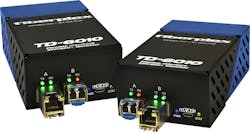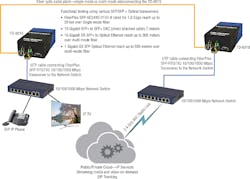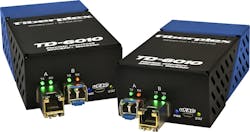By BIJU OOMMEN -- Bandwidth usage is increasing and we never seem to have enough of it. The full range of applications and associated systems -- such as streaming video, video conferencing, two way telepresence, fifth-generation mobile networks (5G), streaming 4K/UltraHD TV, Augmented and Virtual Reality (AR/VR) which are new forms of immersive media, Internet of Things (IoT), High-Speed Internet Access (HSIA), cloud computing-based communications and storage architectures, automation technologies, and more -- are available and plausible only if you have adequate bandwidth.
Indeed, fiber-optic communication systems can deliver the required high bandwidth and high-speed connectivity. For fiber optic communication systems, transceivers with hot –swappable Small Form Factor pluggable (SFP) / SFP+ optical and electrical modules can enable quick and cost-effective fiber-optic connectivity for many deployment scenarios and applications. Just slot in the SFP module and, presto, your application connectivity is up -- and if you are a service provider, you are ready to serve your subscribers.
One such SFP / SFP+ product that can prove very useful is Patton’s FiberPlex TD-6010 12.5 Gbps transceiver. Network and interface upgrades are easy because the SFP’s are interchangeable on the TD-6010. Further, you do not have to maintain a fleet of equipment/devices for repairs or upgrades of your current infrastructure or a change in applications. The choice is yours; you select the modules all based on your needs, applications, and required setup.
The Patton slide-in SFP modules provide unparalleled flexibility for various media types, distances and applications. The current scenario dictates that we must accommodate the continuing growth in data traffic and the increasing demand for bandwidth, while concurrently optimizing and managing the fiber infrastructure and rolling out services. This calls for a combination of functions like media conversion, mode conversion, signal repeating, fiber-optimization, optical wavelength conversion, video formats to fiber conversion etc.
RELATED: Patton Electronics, FiberPlex merge businesses
Patton’s FiberPlex TD-6010 12.5 Gbps transceiver units fit that need and can be used in a variety of applications, which are manifold. Namely the TD-6010 can be used as a: 10/100/1000 Ethernet to Fiber converter; fiber-optic repeater; optical wavelength converter (1310nm/1550nm); multimode to single-mode converter; optical standard duplex to single fiber (BiDi) transport; 4K UHD video to fiber converter; video format converter; ASI, SD-SDI, HD-SDI and 3G-SDI to fiber converter; HDMI/DVI to fiber converter; MADI to Ffber converter, and more.
With regard to SFPs, I would like to briefly make a special mention of Patton’s Bi-Directional Optical Module (BIDI). When this is installed in the FiberPlex TD-6010 12.5 Gbps transceiver unit, you need use only one optical fiber. That is because the BIDI SFP with its one port uses an integral WDM coupler (wavelength diplexers) to transmit and receive over one optical fiber strand. Let’s say you want to double the data traffic or to optimize the usage of the fiber plant that is in place. For both these situations the BIDI SFP can help you by getting you connected on a single fiber. Using Patton’s BIDI optical module, you can transmit and receive signals on a single fiber strand, effectively doubling your fiber capacity.
For example, if you have a 24-core fiber cable, normally you would have twelve working links, but now with Patton’s BIDI you will get 24 links. The spare fiber strand can instantly double the data traffic or provide redundancy as well as additional connectivity in the future. The net effect is that you do not have to rip up your pavement, driveway and/or streets as you run out of fiber strands. This can also result in significant cost savings, especially when you would like to optimize the existing optical fiber cabling plant, or when as a service provider you have to rent the optical fiber, or simply when optical fiber resources are insufficient. Thus, last mile network access applications and architectures can deliver very high bandwidth for voice, data and video subscriber services even with a single strand of fiber. Based on your application and deployment strategy, slot in the appropriate SFP or SFP+ module and you are in business.
Now let’s test Patton’s FiberPlex TD-6010 12.5 Gbps transceiver unit, focusing on the module’s 10/100/1000 Ethernet to fiber network campus extension, so that we can deliver public/private cloud IP services such as SIP trunking, streaming media and video-on-demand. In Fig-A (below), a point to point configuration over a multimode and or single-mode fiber-optic cabling plant is pictured.
Fig. A: H.Q to Campus Network extension for IP Services over Fiber.
Testing
For the test set-up we used the 10/100/1000 BASE-T Fiber Link Kit-Model #: TKIT-ETH-S. This kit from Patton as depicted in Fig.B andcomes pre-configured for 10/100/1000 Base-T Ethernet to single-mode optical conversion at 1.25Gbps / 1310nm over 2km and also includes the required AC power adapters.
Fig.B: TKIT-ETH-10/100/1000 BASE-T Fiber Link Kit
In the TKIT-ETH-S kit, each TD-6010 has two SFP slots labelled as “SFP-Port A” and “SFP-Port B.” SFP Port A is pre-configured with the Fiberplex SFP-SC24XC-3131-B, which supports a 1.2 Gbps data rate up to 20 km over single-mode fiber. SFP-Port B is equipped with the Fiberplex SFP-RTGTXC-0000-0 for Gigabit Ethernet and 10/100/1000- BASE-T standards as per IEEE 802. 3-2002 and IEEE 802.3ab, supporting 1000 Mbps data rates up to 100 meters of reach over unshielded twisted-pair CAT 5 cable.
On the unit itself, there are visual LED indicators associated with each SFP slot and a power LED. These convey the operational statuses for: Power; TX fault; RX detect; SFP installed; Transmitter functioning; and Receive signal present. We wanted to functionally test extending the Ethernet network from the company HQ to a campus location (refer to the connectivity diagram in Fig-A.) We successfully delivered from a public/private cloud IP services such as a SIP trunk, streaming media and video on-demand to the campus.
Let’s go a step further and complete functional testing using 3rd party SFP/SFP + optical transceiver modules on the TD-6010. The 3rd party SFP/SFP + optical transceivers we used for our testing were a: 10 Gigabit SFP+ to SFP+ DAC (Direct attached Cable) of 7 m; a 10 Gigabit SR SFP+ optical Ethernet multimode fiber reach up to 300 m; and a 1 Gigabit SX SFP optical Ethernet multimode fiber reach up to 550m. The functional testing was successful with all the above mentioned 3rd party SFP and SFP+ optical transceivers.
Patton’s FiberPlex TD-6010 12.5 Gbps Transceiver unit is a very simple unit to set up. We were impressed by the simplicity of installation and versatility of the units in that by swapping the SFPs it lends itself to a variety of deployment/application scenarios.
Conclusion
Patton’s FiberPlex TD-6010 12.5 Gbps transceiver unit is a very handy tool to keep in your toolkit. It can help with your equipment solution goals such as flexibility, inventory management, and plug-and-play. Simply put, with this module your deployment flexibility increases immensely. This platform will extend the reach of your network, and also help in media conversion, mode conversion, video formats to fiber conversion, optical wavelength conversion, as well as fiber-optimization in general.
BIJU OOMMEN has 15+ years of experience in helping deploy best-of-breed enterprise as well as carrier grade solutions, and in providing leading-edge systems integration services. Much of his work revolves around multi-vendor product and technology integration. It spans the domains of voice, VoIP, Fiber, WiFi, Microwave, SAN, IP networks, e-mail and network security. He has independently and successfully implemented projects related to Telecommunications, Networking/IT Infrastructure, and Wireless Communications for a diverse client portfolio including the financial and government sectors. His passion for technology has seen him regularly test and pen technical articles for various journals in the U.S, U.K, and Canada, encompassing areas such as VoIP-H.323/SIP, SDH, Eos, WiFi, SSL VPN, application acceleration, E-mail firewall, SEM, SAN etc.


